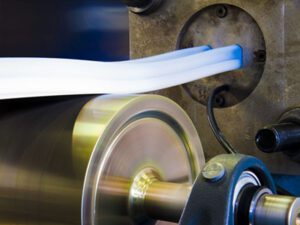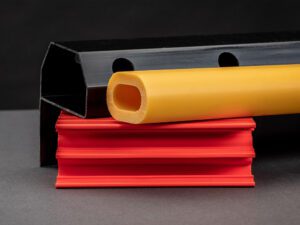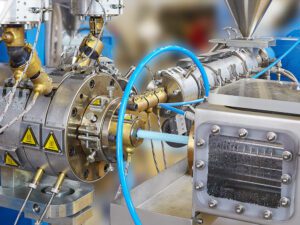What Is Extrusion?
Definition: Extrusion is a manufacturing method that forces material through a shaped opening (the die) to create a continuous profile with a fixed cross section.
Key Benefit: High output rate and low per‑unit cost.

What Is Plastic Extrusion?
Plastic extrusion melts thermoplastic resin and pushes the molten mass through a die to form continuous shapes—pipes, profiles, sheets, films, and more. It’s ideal for large‑volume production of uniform‑section products.
Core Extruder Components
| Component | Function |
| Hopper | Stores and feeds plastic pellets into the barrel |
| Barrel & Screw | Heats, mixes, and conveys the molten plastic |
| Breaker Plate | Filters out contaminants and stabilizes backpressure |
| Die | Shapes the molten plastic into the desired profile |
| Cooling System | Solidifies and calibrates the extruded profile |
Step‑by‑Step Plastic Extrusion Process
- Feeding: Plastic pellets drop from the hopper into the barrel by gravity.
- Melting: The barrel has three heating zones; temperature rises progressively to melt the plastic.
- Filtration: Molten plastic passes through a breaker‑plate and screen pack that remove impurities.
- Shaping: The filtered melt is forced through the die, forming the required cross‑section.
- Cooling & Calibration: The extruded profile enters a water or air‑cooling tank to solidify and maintain dimensional accuracy.
- Cutting or Winding: Once solidified, the profile is cut to length or wound onto reels.

Four Common Plastic Extrusion Types
| Type | Application Examples | Notes |
| Tubing Extrusion | Hoses, pipes | Uses internal air pressure to form hollow sections |
| Blow Film Extrusion | Shopping bags, packaging film | Melt blown into a bubble; ideal for thin films (< 100 µm) |
| Sheet Film Extrusion | Plastic sheets, cartons | Calendering or rolling to cool thicker sheets (> 100 µm) |
| Jacket Extrusion | Wire & cable insulation jackets | Coating wire with polymer for protection and insulation |
Materials Used in Plastic Extrusion
| Material | Typical Melt Temperature | Key Properties |
| Polyethylene (PE) | ~ 200 °C | Chemical resistance, toughness |
| Polypropylene (PP) | ~ 220 °C | Fatigue resistance, rigidity |
| PVC | 160–180 °C | Flame retardant, dimensional stability |
| Nylon (PA) | 240–260 °C | Wear resistance, high strength |
| Polystyrene (PS) | ~ 200 °C | Transparency, rigidity |
Key Applications
- Wire & Cable Insulation: Excellent electrical insulation for cables and jackets.
- Piping & Tubing: Durable pipes for water, gas, and chemical transport.
- Weather Stripping: Seals around doors and windows to prevent air and water infiltration.
- Packaging Films & Sheets: Flexible packaging for food, consumer goods, and industrial wraps.
- Profiles & Edge Trims: Custom extruded trims for automotive, construction, and furniture applications.

Plastic vs. Aluminum Extrusion
| Feature | Plastic Extrusion | Aluminum Extrusion |
| Temperature Range | 160–260 °C | Cold (room temp) or 350–500 °C |
| Material Strength | Moderate | High |
| Electrical Conductivity | Insulator | Conductor |
| Recyclability | Good | Excellent |
| Typical Products | Seals, tubes, films | Frames, bars, heat sinks |
Conclusion
Plastic extrusion delivers cost‑effective, flexible, high‑volume production for a wide range of continuous profiles. By mastering extruder components, process steps, material selection, and application areas, manufacturers can optimize quality and minimize costs.
Contact Okin to costumize your plastic extrusion components!
